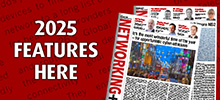22 March 2023
Markus Nispel, CTO of EMEA, Extreme Networks
In 2022, the local government installed approximately 3,500 WiFi 6 access points throughout the city, making it one of the largest public cloud-managed network infrastructures in Europe. This shining new infrastructure provides safe and reliable internet access for everyone, be it individuals, businesses, or public services.
The project illustrates how cloud-managed networking can be the foundation for further innovation. It sets the stage for cutting-edge solutions such as WiFi-based medical wristbands that allow doctors to monitor critical patients’ heartbeats and locations. It also provides the city with valuable analytics that will help them provide better services for their visitors and citizens. While the phrase ‘smart city’ is thrown around a lot these days, Borås might well be one of the few truly deserving of the title, at least in terms of networking.
The question is, why isn’t this already the norm?
Better late than never
The pandemic widely accelerated adoption of new technology, from cloud-based videoconferencing to integrated AI, yet the adoption of cloud-managed networking is only now starting to pick up the pace. Why? The ability to scale quickly and reduce complexity in the light of IT skillset drive the need for it. Until now, many IT teams have chosen to err on the side of caution and ‘leave well enough alone.’ But those days are quickly coming to an end.
Regardless of how efficient your IT team is, legacy network management has also become a serious drain on resources. Not only does it require recruiting employees with the appropriate skills (which can be a time-consuming and costly process considering the current shortage of IT talent), but it also means that employees must spend hours at a physical site resolving issues when they occur. This, in turn, requires yet more resources and investment. And these problems will only grow as the workforce becomes ever more hybrid, spread across offices and geographies. Cloud-managed networking enables AIOps to automate operations further and save valuable time and resources while providing superior user experience to customers and consumers.
Cloud-managed networking offers an obvious solution, allowing IT teams to become proactive. On top of that, the rise of as-a-service models is allowing some organisations to let go of in-house network management completely. Instead, they simply pass the torch to an external service provider.
Then there’s the ‘always-on’ expectation. Using legacy software to roll out patches and updates will ultimately become unmanageable as businesses increasingly operate across time zones. This means downtime will always inconvenience someone. Because cloud-based network management applications that are developed as cloud native applications, it’s quick to update and simple to reconfigure individual components (rather than entire apps), thus avoiding downtime and interruption to services.
Take Bayerische Zugspitzbahn, for example, which provides hospitality and cable car transportation services for Germany’s tallest mountain. Its network needs to stay online, always. Any downtime is potentially a small disaster, bringing ticketing, hospitality, and transportation to a halt; nobody wants to be stuck dangling high up in a cable car in freezing temperatures. This is complicated further because onsite maintenance is a serious challenge, with much of the organisation's networking infrastructure either buried in snow for large portions of the year or only accessible on foot. In other words, it’s hardly surprising that Bayerische Zugspitzbahn switched to cloud-based network management, which offers an easy solution for remotely managing hardware that is otherwise difficult to reach.
Insights and analytics
For many organisations, the shift to cloud-managed networking won’t be as dramatic as the scale and scope of Borås Stad, nor the specific challenges of Bayerische Zugspitzbahn. But regardless of size and circumstance, it will unlock priceless data-backed insights and analytics through machine learning and artificial intelligence (ML/AI) leading to true AIOps.
An example of this is Manchester United Football Club, which has adopted cloud-managed networking at and around Old Trafford. Its IT team will now have easy access to vast quantities of real-time data, distilled into digestible reports. Fan foot traffic, app usage in the stadium, popular concessions, and at which points during the match fans are digitally engaged; it’s all in the report. Armed with this data, the club can make key improvements to its operational efficiency on match days and make informed, long-term strategic decisions.
Always on operations
Another element of cloud managed networking is the opportunity to automate updates, preventing delays to bug fixes or patches – a common cause of security breaches.
This was a crucial factor for NJ Transit when it let go of its legacy network management solution in favour of a cloud-based solution. Being one of the USA’s largest public transportation systems, it manages 166 rail stations, 62 light rail stations, and more than 19,000 bus stops. Naturally, ensuring security and maximising uptime were key priorities that cloud-managed networking improved upon.
The infinite enterprise
In the end, legacy network management software is often a one-size-fits-all solution to a dynamic problem. In contrast, cloud-managed networking lets organisations create the network they need, when they need it. It simplifies management, amplifies scalability, and creates a foundation for near unlimited innovation and potential. Scaling and maintenance of wireless LAN controllers, constant on-site interventions, and wasted resources will become a thing of the past.
The pandemic was a catalyst for change, yes, but the winds of change are still blowing. Cloud-based networking solutions are catching up with the other digital transformations. Borås, Bayerische Zugspitzbahn, NJ Transit, and Manchester United are all great examples of that.
Increasingly, we work across multiple locations, devices, systems, and solutions; we use live documents, cloud storage, cloud meetings; as consumers, we expect seamless digital experiences. To keep up, network administrators will be forced to ensure that their users receive the same high-end experience – whether they’re in Borås, Bayern, Manchester, or New Jersey. To accomplish that, they’ll need to let go of fragmented legacy solutions and move to the cloud.
In this brave new world, we’ll need to evolve and scale our systems, applications, and networks to fit the user’s everchanging needs – and cloud-managed networking is a central part of that process. Good thing it’s finally catching up.










